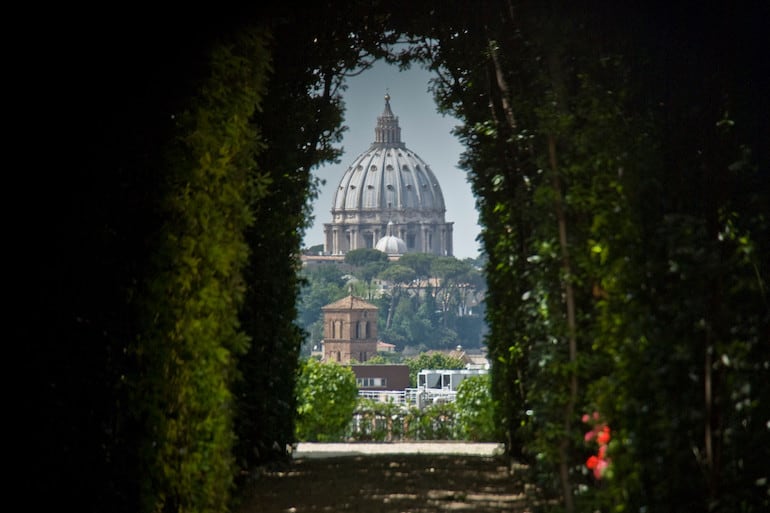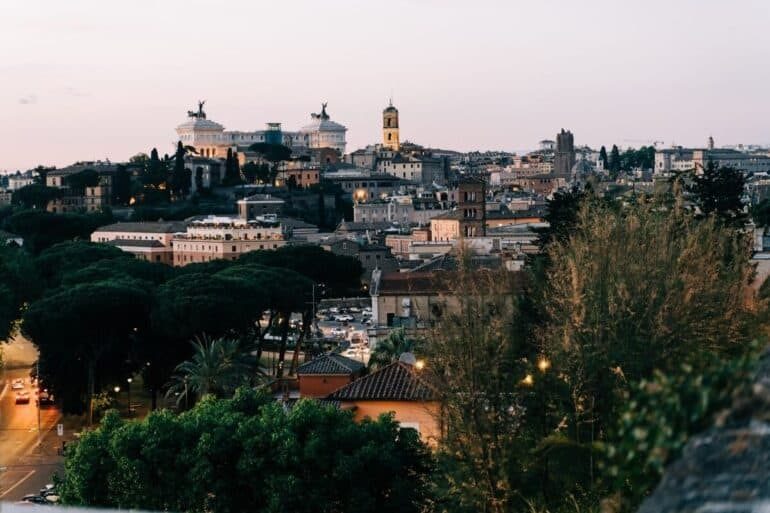What Are The Seven Hills of Rome and What Can You See?
The famed Sette Colli di Roma – Palatino, Aventino, Celio, Capitolino, Esquilino, Quirinale, and Viminale – have characterized The Eternal City since its founding. Though the city now contains more than seven hills, (like The Janiculum, for example), these seven were the ones contained within The Servian Walls. which were built in 4th Century B.C.E. to protect the city from invasion. Lying east of the River Tiber and making up central Rome’s sloping landscape, the hills are sure to elevate your knowledge of Italy’s capital.
Palatine Hill (Palatino)

When the well-known twins Romulus and Remus were left in a basket on the River Tiber, they were washed ashore at the base of The Palatine Hill. It was The Palatine on which the twins were nursed to strength by the legendary she-wolf, (lupa) and where Romulus later established his city, Rome. At the base of The Palatine, there are, of course, the Roman Forum and Colosseum. These were places of thought and conflict, respectively.
If you’re looking for something different, with a more relaxing purpose, visit the Baths of Caracalla. These were the second largest baths in the ancient city, completed in 216 C.E., and their ruins are the most complete of any Roman bathhouse today.
Aventine Hill (Aventino)

Before Romulus established Rome on The Palatine, the twin brothers disagreed about where to place their city. Remus favored The Aventine Hill, but he did not live to see his wishes through. Remus was either killed in an accident, by a Romulus-supporter, or by Romulus himself, leaving The Aventine out of the founding of Rome.
Remus’ favored hill is the southernmost of the seven and its position helps create its brightest gem: The Giardino degli Aranci. From the garden, also known as Parco Savello, one can enjoy an expansive, North-facing view of the city while surrounded by greenery. Nearby, check out the Piazza dei Cavalieri di Malta, or “The Keyhole,” which provides a focused, otherworldly view of The Vatican.
Caelian Hill (Celio)

During Rome’s Republic era, The Caelian Hill was the realm of the wealthy. It was originally named Mons Querquetulanus, because of the many oak trees said to have covered the hill. To ascend the Caelian Hill, follow Clivo di Scauro, an ancient Roman road on which you’ll find the entrance to the Case Romane del Celio. The “Houses of Rome” offer a glimpse into how ancient Roman Christians lived. Located underneath the Basilica dei Santi Giovanni e Paolo, the museum and archaeological site contains the residence of martyrs John and Paul, an apartment block, and preserved frescoes.
The Caelian Hill is near the Colosseum and the furthest southeast of the hills. On The Caelian, visit the Villa Celimontana. The Villa includes beautiful gardens which, in Medieval times, were filled with vegetables and vineyard grapes, and now include sculptures and an ancient Egyptian obelisk (Obelisco Matteiano).
Capitoline Hill (Campidoglio)

Rivaling the importance of The Palatine in ancient times, The Capitoline Hill was home to The Tabularium, the city archive; The Temple of Jupiter Optimus Maximus, the most important temple in ancient Rome; and The Tarpeian Rock, a steep cliff where traitors met their deaths. On The Capitoline Hill, you must visit The Piazza del Campidoglio, a plaza designed by Michaelangelo in 1536.
Located in the plaza are The Capitoline Museums, which—though on the beaten path—are essential to see. They’re located in The Palazzo Nuovo and Palazzo dei Conservatori, and together, make up the first public museum in the world. Here, you can view the statue of the she-wolf who Romulus and Remus suckled from during their infant years.
Esquiline Hill (Esquilino)

Gracing the top of the Esquiline hill is the Patriarchal Basilica of Santa Maria Maggiore, one of the four major papal basilicas of Rome. The standing structure was built in the fifth century, but the original church is said to have been built according to the guidance of Mary, herself, who appeared to Pope Liberius in 358. She told him to watch for a sign, and the next morning, on August 5, a snowfall had capped the Esquiline hill’s summit. The edges of the snowfall decided the perimeter of the church. Each year, the Basilica is dusted with false snow on August 5 to commemorate the miracle.
At the base of the Esquiline hill, you will find the Arch of Gallienus. The arch stands in the place of what once was the Esquiline Gate, which was built into the Servian Wall and facilitated travel in and out of the eternal city.
Quirinal Hill (Quirinale)

This is the highest of the seven hills, so it’s only fitting that it be home to Palazzo del Quirinale, the seat of the President of the Italian Republic. The Quirinal Palace was built in 1574 by Pope Gregory XIII as a summer escape. An enormous, sprawling mansion, The Palazzo has housed Kings, Popes, and Presidents alike. Book a tour of the palace to wander its gardens: i Giardini del Quirinale.
On The Quirinal Hill, the northernmost hill, you can also walk the halls of Palazzo Barberini, which holds part of The National Gallery of Ancient Art collection, and view masterpieces such as Caravaggio’s Narcissus. Make sure you also visit the tucked-away San Carlo alle Quattro Fontane, a baroque gem of undulating architectural design by Francesco Borromini.
Viminal Hill (Viminale)

Termini, the most trafficked train station in the country, is situated on The Viminal Hill, the smallest of the seven. The original transportation hub became operational in 1873 and was redone in 1950, becoming a symbol of modernity and production post-war. The Viminal Hill also boasts the Piazza della Repubblica. Designed by Gaetano Koch of Turin, Piazza della Repubblica is a wide plaza lined with imposing buildings.
For a cultural, entertaining night of music on The Viminal Hill, visit Teatro dell’Opera di Roma. Originally opened in 1880 and acquired by the city in 1926, the opera house boasts 1600 seats, and will show Notre-Dame de Paris this September.
Bonus: Janiculum Hill (Gianicolo)

If you have time, cross The River Tiber and add a stop on The Janiculum Hill. While not one of the seven, The Janiculum is certainly worth visiting. Fontana dell’Acqua Paola (featured in the opening scene of “La Grande Bellezza”), and Monument to Giuseppe Garibaldi are both magnificent sights to see atop the hill, and Belvedere del Gianicolo provides a beautiful view of the city from a wide terrace.
Centuries of building and development have made the hills’ inclines less dramatic, so you shouldn’t become too winded on this unmissable tour.





